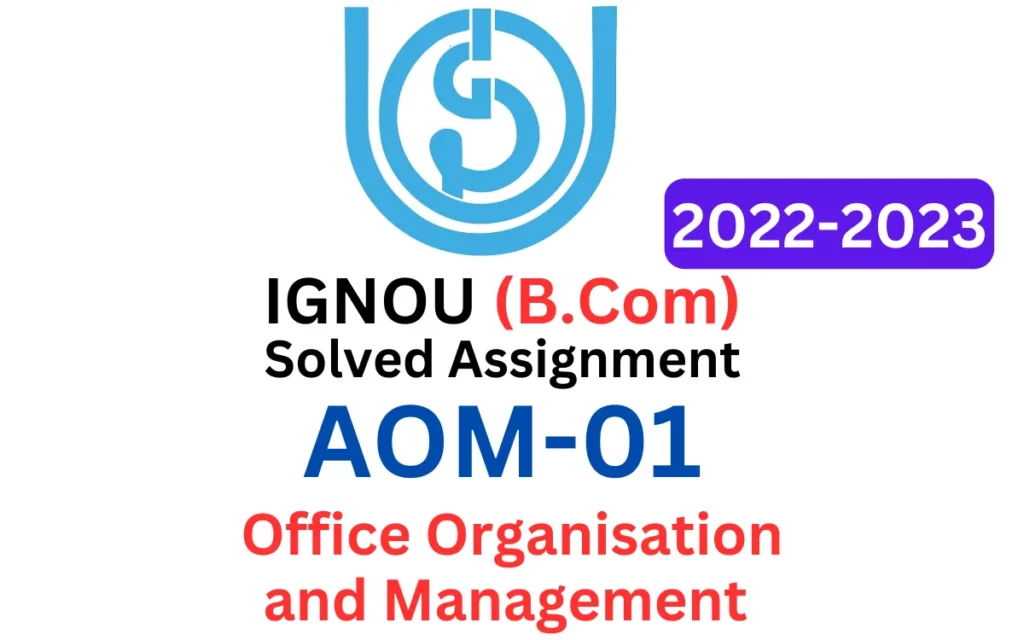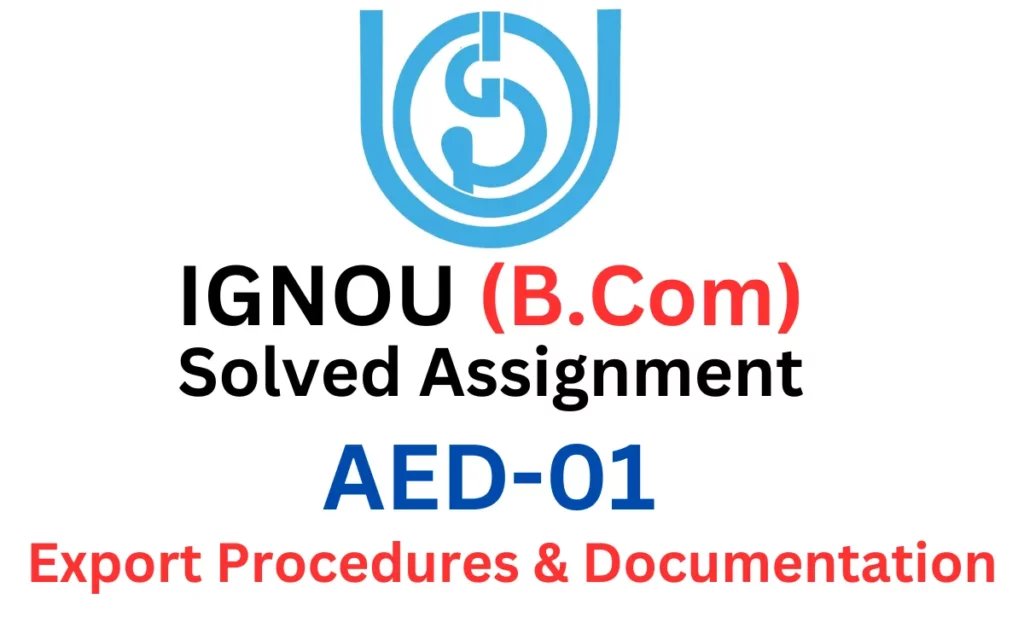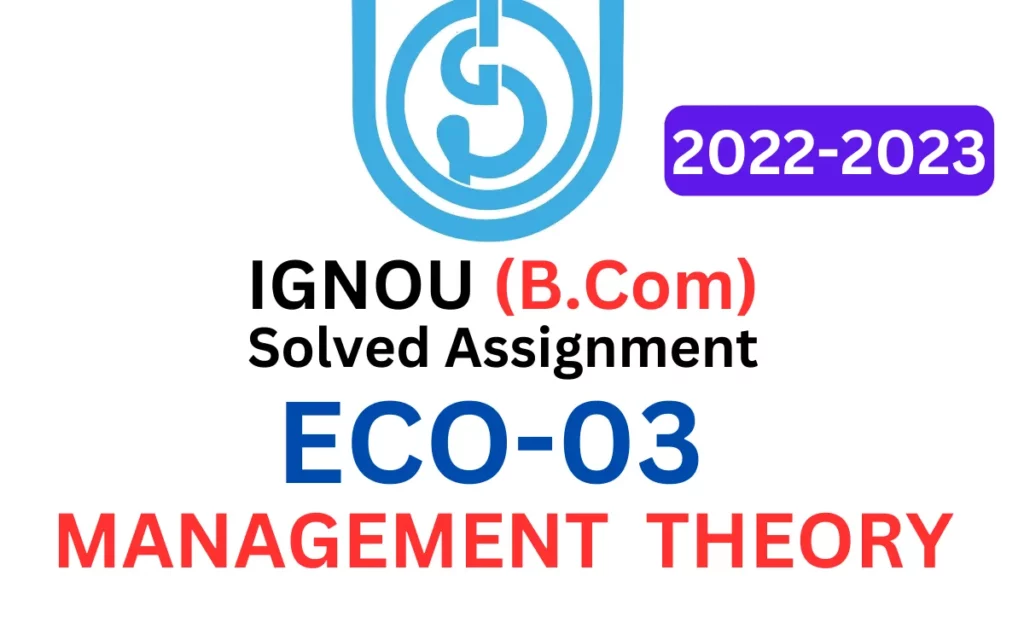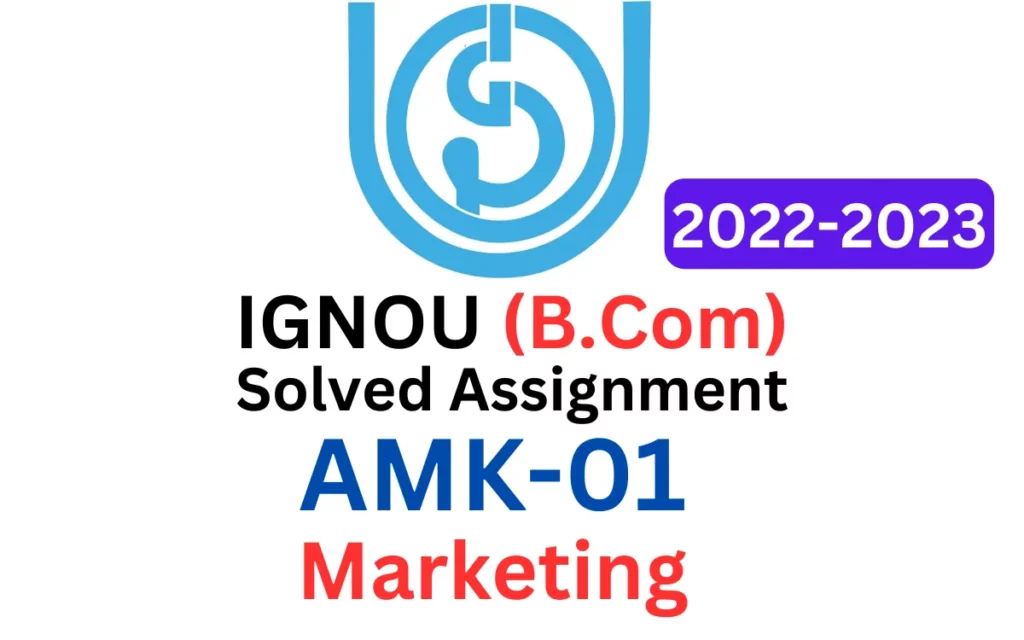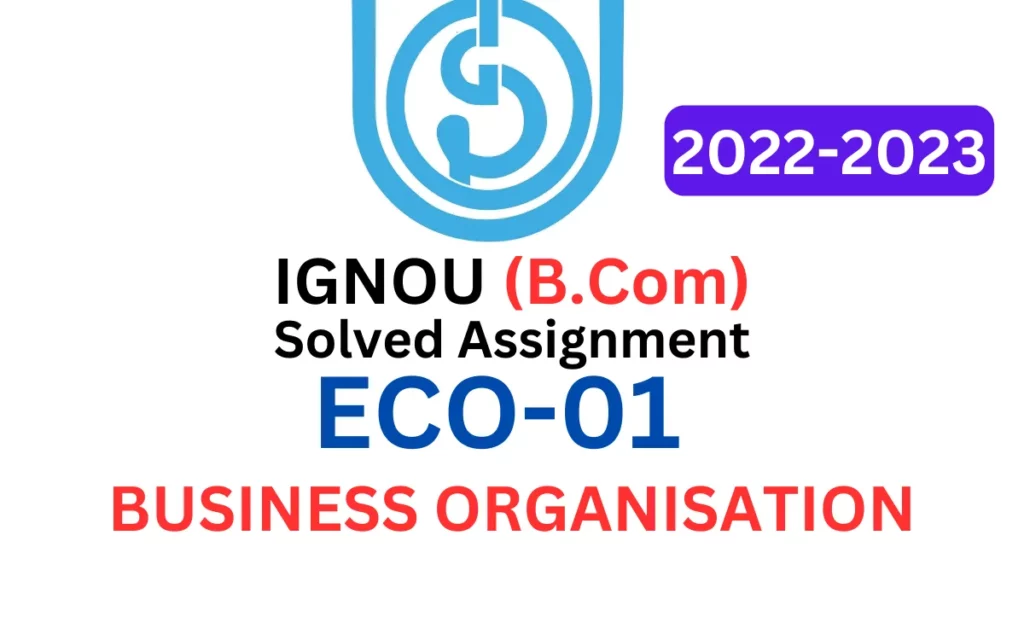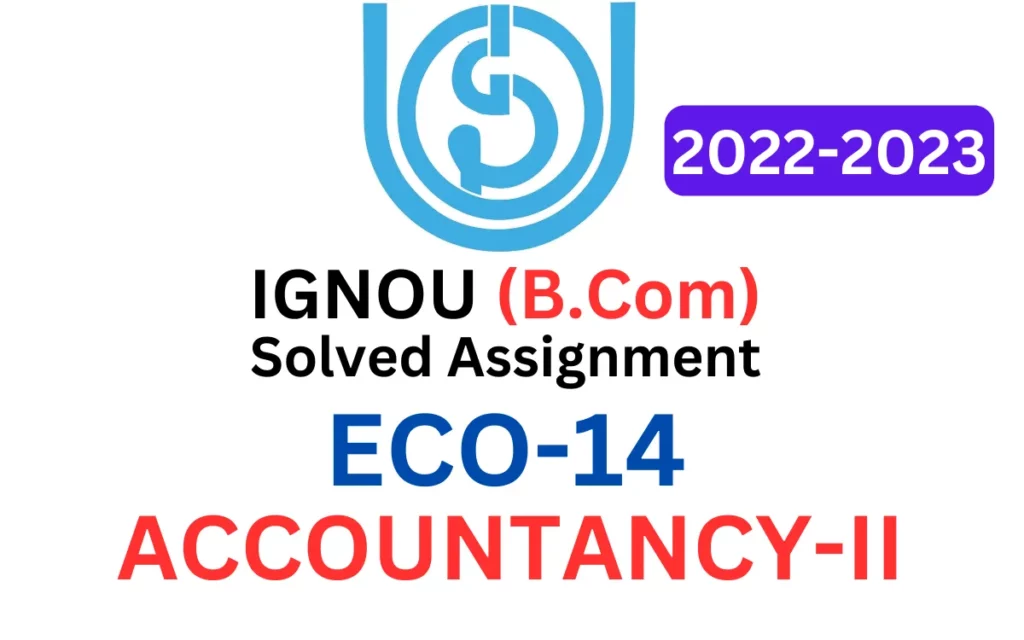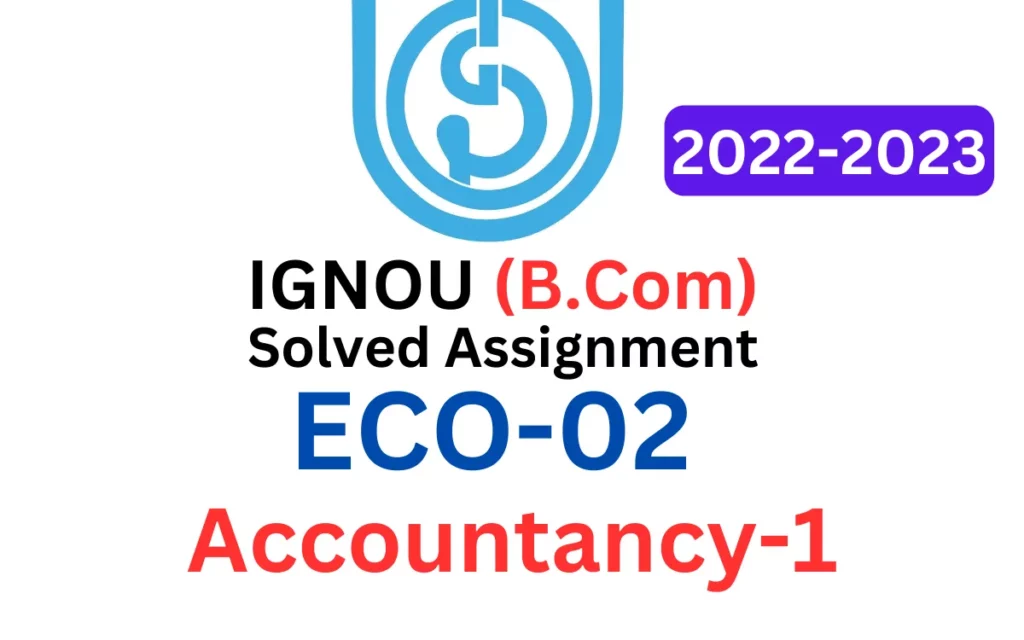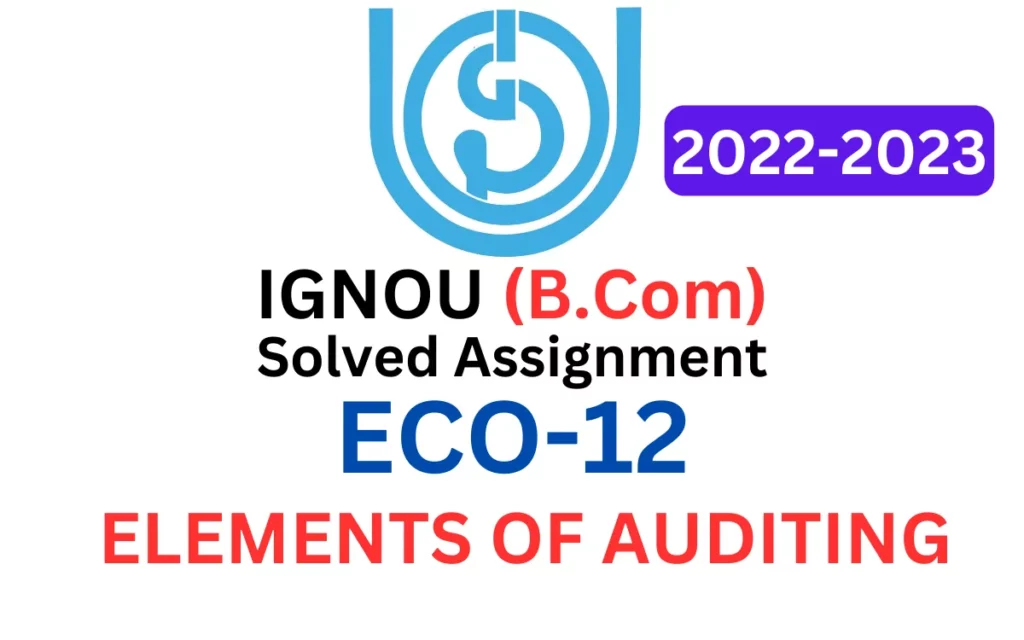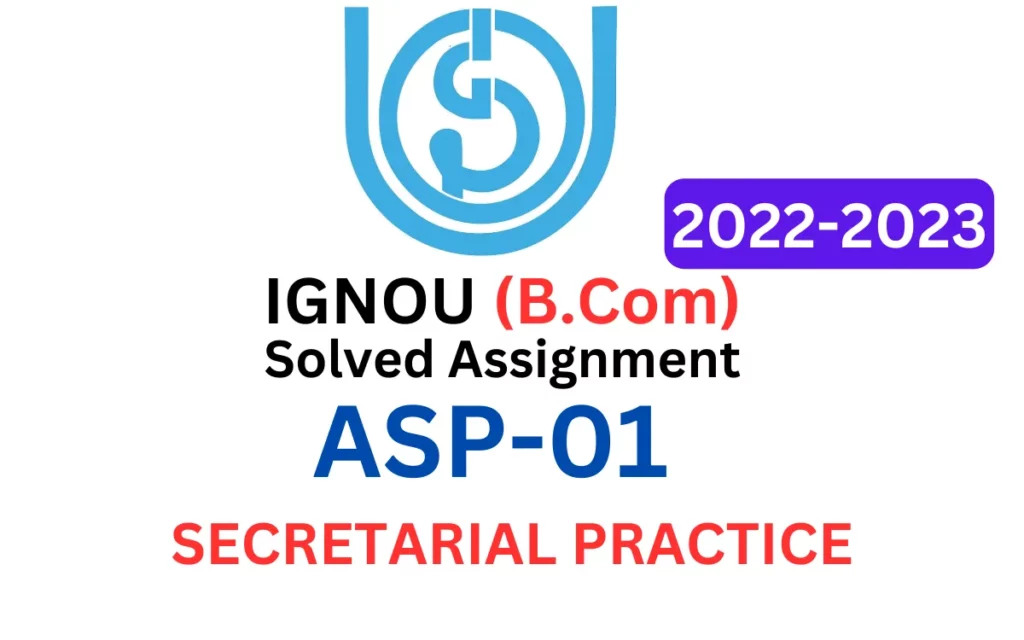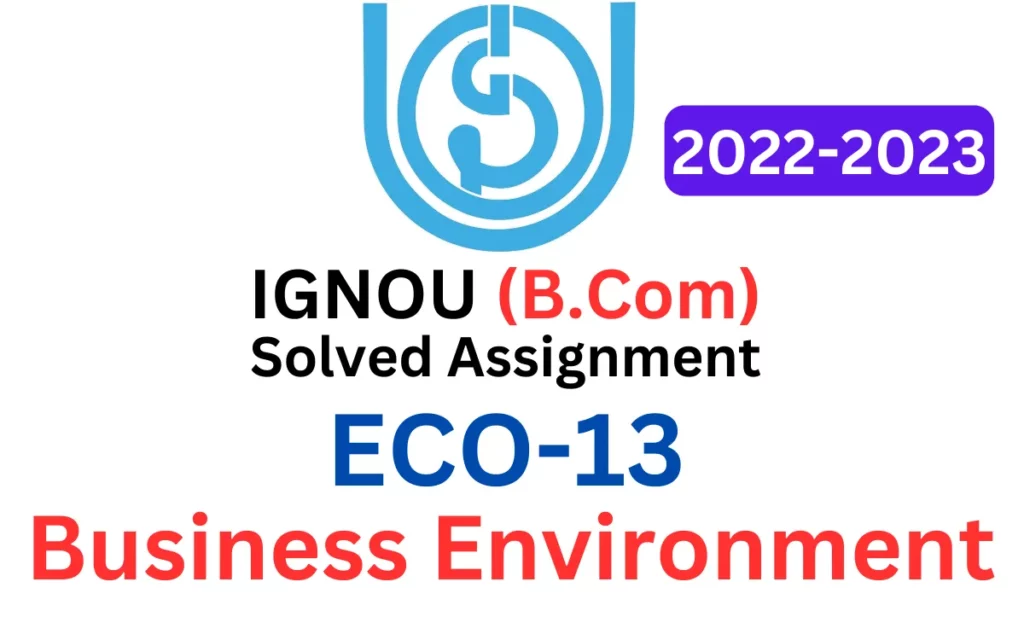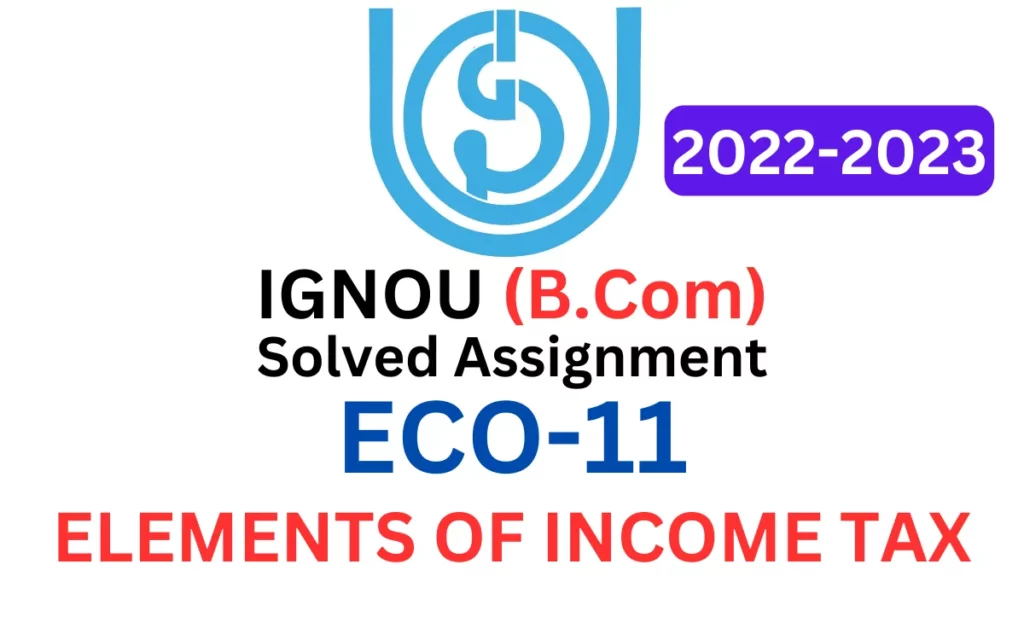Contents
- 1 1. Discuss the significance of written communication for any organization. What are its advantages and limitations?
- 2 2. “The best way of identifying the business choice is to go for a SWOT analysis”. Explain this statement and make SWOT analysis of any business plan you propose to work upon.
- 3 3. (a) List out the steps required in setting up a small enterprise.
- 4 (b) “Entrepreneurs are dreamers as well as risk bearers”. Comment.
- 5 4. (a)What is partnership? State its merits and demerits.
- 6 (b) What factors would you consider before you start Editing and Proofreading?
- 7 5. Write short notes on the following:
- 8 (a) Source of finance
- 9 (b) Business opportunity
- 10 6. Differentiate between the following:
- 11 (a) Financial appraisal and Marketing appraisal
- 12 (b) Writing about facts and writing about opinions
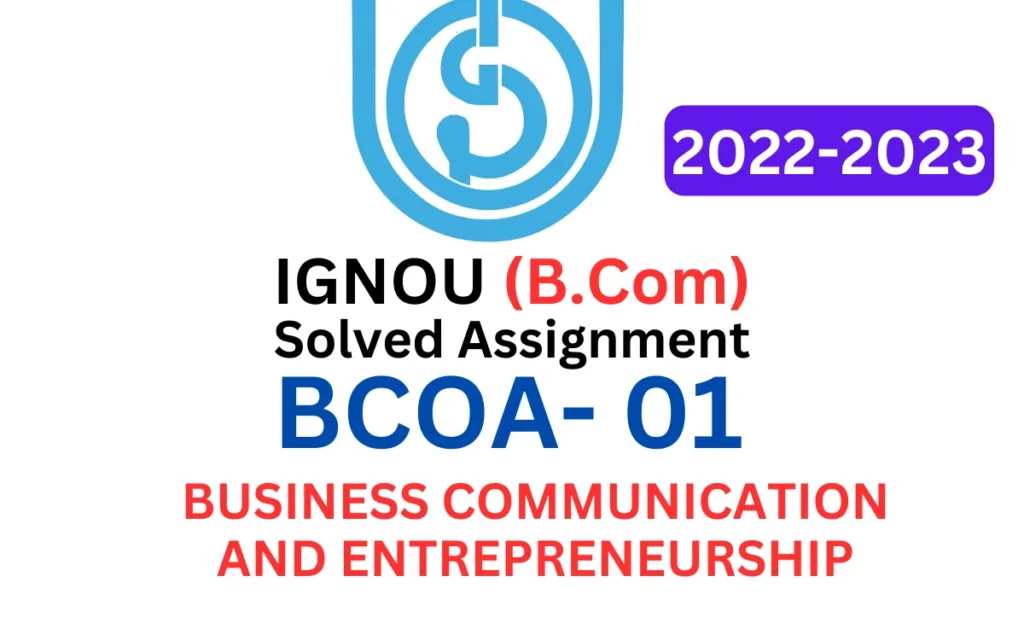
| Title | BCOA- 01: IGNOU B.Com Solved Assignment 2022-2023 |
| University | IGNOU |
| Degree | Bachelor Degree Programme |
| Course Code | BCOA- 01 |
| Course Name | BUSINESS COMMUNICATION AND ENTREPRENEURSHIP |
| Programme Name | B.Com |
| Programme Code | BDP |
| Total Marks | 100 |
| Year | 2022-2023 |
| Language | English |
| Assignment Code | BCOA- 01/TMA/2022-2023 |
| Assignment PDF | Click Here |
| Last Date for Submission of Assignment: | For June Examination: 31st April For December Examination: 30th September |
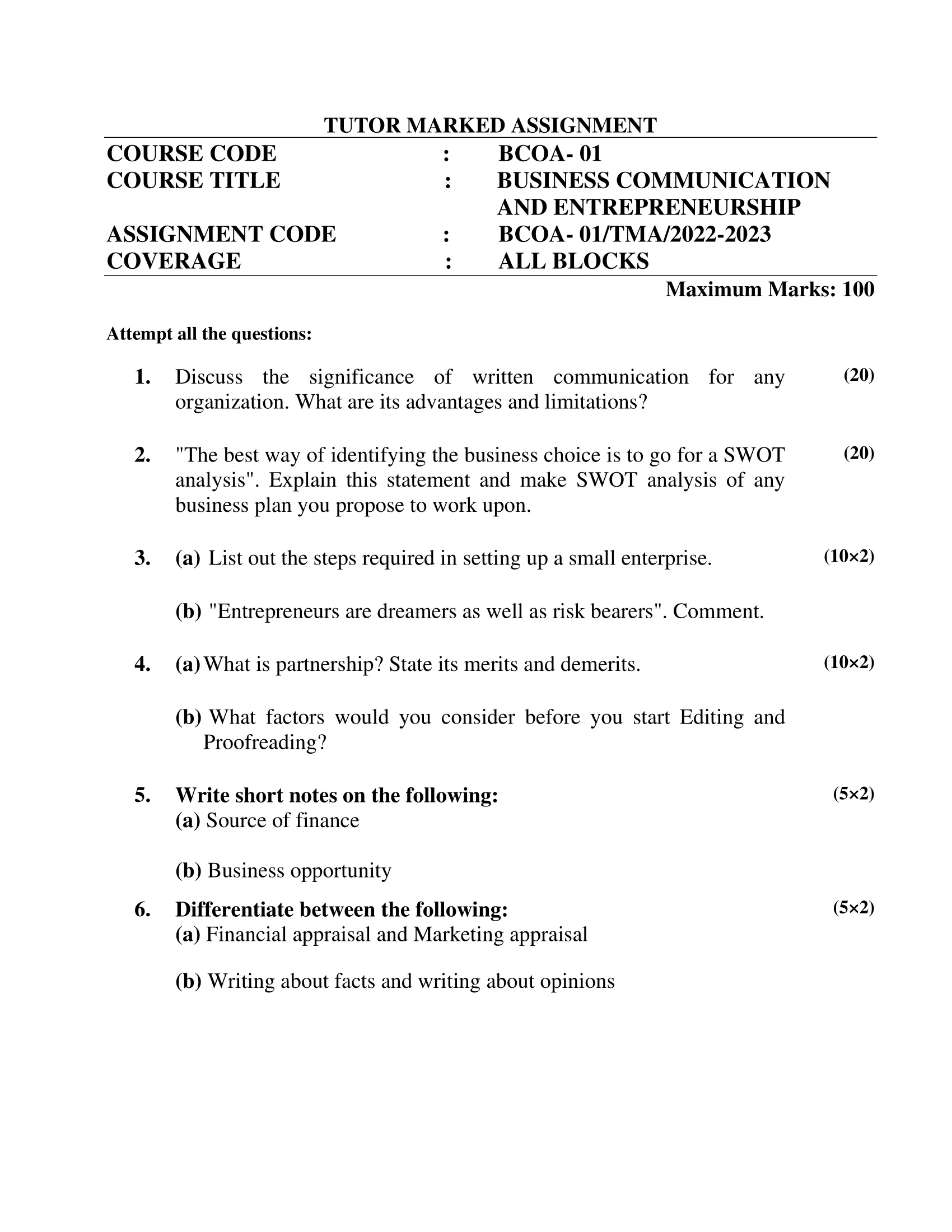
1. Discuss the significance of written communication for any organization. What are its advantages and limitations?
Ans: Written communication is a critical aspect of any organization, as it enables the exchange of information between various stakeholders, including employees, customers, suppliers, and partners. The significance of written communication lies in its ability to provide a permanent record of information, which can be used for reference and documentation purposes. In this sense, written communication plays a vital role in facilitating decision-making, problem-solving, and collaboration within organizations.
Advantages of written communication:
- Clarity and precision: Written communication allows for the expression of ideas and information with clarity and precision, reducing the chances of misinterpretation and misunderstanding.
- Permanent record: Written communication provides a permanent record of information that can be referred to later, avoiding the need for repeated explanations and clarifications.
- Formality: Written communication is a formal way of communicating, which helps to maintain the seriousness and professionalism of the organization.
- Time-saving: Written communication saves time, as it enables the exchange of information without the need for face-to-face interaction.
- Legal protection: Written communication can be used as legal evidence, providing protection for organizations in case of disputes or legal issues.
Limitations of written communication:
- Lack of personal touch: Written communication lacks the personal touch of face-to-face interaction, which can sometimes lead to misunderstandings or misinterpretations.
- Limited feedback: Written communication does not allow for immediate feedback, which can hinder the ability to clarify information or respond to questions.
- Inflexibility: Written communication is inflexible, as it cannot be changed once it has been sent, unlike verbal communication which can be corrected in real-time.
- Language barriers: Written communication can be hindered by language barriers, particularly in multi-lingual organizations, leading to miscommunication or misinterpretation.
2. “The best way of identifying the business choice is to go for a SWOT analysis”. Explain this statement and make SWOT analysis of any business plan you propose to work upon.
Ans: The SWOT analysis is a useful tool for identifying the strengths, weaknesses, opportunities, and threats of a business idea or plan. It provides an overview of the internal and external factors that can impact the success of the business and can be used to identify the best course of action.
Strengths: The strengths of a business are the internal factors that contribute to its success. These can include the unique features of the product or service, the expertise of the team, the reputation of the brand, and the competitive advantage that the business has over its rivals.
Weaknesses: Weaknesses are the internal factors that can hinder the success of the business. These can include the lack of resources, limited expertise, poor financial management, or inadequate marketing strategies.
Opportunities: Opportunities are external factors that can contribute to the success of the business. These can include market trends, changes in consumer behavior, advancements in technology, or changes in regulations.
Threats: Threats are external factors that can pose a risk to the success of the business. These can include competition, economic conditions, changes in consumer preferences, or external events such as natural disasters or pandemics.
Example SWOT analysis for a small business plan:
Strengths:
- Unique product offering
- Experienced and knowledgeable team
- Strong customer base
- Low overhead costs
Weaknesses:
- Limited financial resources
- Lack of brand recognition
- Limited marketing budget
- No physical store location
Opportunities:
- Growing demand for eco-friendly products
- Increase in online shopping
- Partnerships with influencers and bloggers
- Expansion into new markets
Threats:
- Competition from established brands
- Economic downturns
- Political and regulatory changes
- Supply chain disruptions
Based on this SWOT analysis, the proposed business plan could leverage its strengths, such as its unique product offering and experienced team, to capitalize on opportunities in the market. However, the plan would need to address weaknesses such as limited financial resources and lack of brand recognition by developing effective marketing strategies and seeking out partnerships with influencers and bloggers. The plan would also need to be aware of potential threats such as competition from established brands and supply chain disruptions and take appropriate measures to mitigate these risks.
3. (a) List out the steps required in setting up a small enterprise.
Ans: Setting up a small enterprise can be an exciting but challenging task. Here are the steps required to start a small enterprise:
- Conduct market research: The first step in setting up a small enterprise is to conduct market research to identify the demand for the product or service, potential competition, and target customers. This will help in developing a viable business plan.
- Develop a business plan: A business plan outlines the objectives, strategies, and financial projections of the enterprise. It is an essential document that serves as a roadmap for the enterprise’s success and can be used to secure funding from investors.
- Choose a legal structure: The next step is to choose a legal structure for the enterprise, such as a sole proprietorship, partnership, or limited liability company. This will depend on factors such as the number of owners, liability protection, and tax implications.
- Register the enterprise: The enterprise must be registered with the appropriate government agencies, such as the Registrar of Companies, to obtain the necessary licenses and permits to operate.
- Secure funding: Funding is essential for setting up and running a small enterprise. Funding can be obtained from various sources such as personal savings, loans, grants, or crowdfunding.
- Set up a business location: Depending on the nature of the enterprise, a business location may be required. This could be a physical storefront, office, or a virtual location such as a website.
- Hire employees: If the enterprise requires employees, the hiring process should be initiated. This includes developing job descriptions, advertising vacancies, and conducting interviews.
- Launch the enterprise: Once all the above steps are complete, the enterprise is ready to launch. The launch should be accompanied by an effective marketing strategy to generate awareness and attract customers.
- Monitor and evaluate performance: After the enterprise is launched, it is essential to monitor and evaluate its performance regularly. This will help in identifying areas for improvement and making necessary adjustments to ensure success.
(b) “Entrepreneurs are dreamers as well as risk bearers”. Comment.
Ans: Entrepreneurship is all about creating something new and valuable by taking calculated risks. Entrepreneurs are individuals who identify a gap in the market, develop a business idea, and take the necessary steps to turn that idea into a successful enterprise.
Entrepreneurs are often referred to as “dreamers” because they have a vision for the future and are driven by their passion for turning that vision into a reality. They are not content with the status quo and are always looking for ways to improve or innovate.
At the same time, entrepreneurs are also “risk bearers” because they are willing to take calculated risks to achieve their goals. Starting a new enterprise involves a great deal of uncertainty, and entrepreneurs must be prepared to face challenges and overcome obstacles. This requires taking risks such as investing personal savings, borrowing money, or taking on debt to fund the venture.
Successful entrepreneurs are those who have the ability to balance their dreams with the risks involved in pursuing them. They have the vision to see the potential in their ideas, the determination to overcome obstacles, and the courage to take risks to achieve their goals.
4. (a)What is partnership? State its merits and demerits.
Ans: Partnership is a business structure where two or more people join together to run a business and share the profits and losses of the business. Partnerships are often formed between friends, family members, or colleagues who share a common interest in a particular business or industry.
Merits of Partnership:
- Shared responsibility: In a partnership, the responsibility of running the business is shared between the partners. Each partner brings their skills, knowledge, and experience to the table, allowing for a more effective and efficient business operation.
- More resources: With multiple partners, there is more capital available to invest in the business. This can lead to increased resources, such as better equipment, more staff, or increased marketing efforts.
- Shared risk: As partners share the profits and losses of the business, the risk is spread among them. This can help reduce the financial burden on any one partner if the business runs into trouble.
- Flexibility: Partnerships are relatively easy to set up and can be tailored to suit the needs of the partners. This can include different levels of input and control over the business.
Demerits of Partnership:
- Unlimited liability: Partners in a partnership have unlimited liability, meaning that they are personally liable for the debts and obligations of the business. This can put their personal assets at risk if the business runs into financial difficulties.
- Shared profits: While sharing profits can be a benefit of a partnership, it can also be a disadvantage. Each partner is entitled to an equal share of the profits, regardless of their level of input or effort.
- Potential for disagreements: Partnerships can be vulnerable to disagreements and conflicts, particularly if partners have different ideas about how the business should be run. These disagreements can lead to a breakdown in the partnership and ultimately the business.
- Limited lifespan: Partnerships have a limited lifespan, as they are dependent on the health, willingness, and agreement of the partners involved. The exit or death of one partner can lead to the dissolution of the partnership.
(b) What factors would you consider before you start Editing and Proofreading?
Ans: Before starting the editing and proofreading process, it is important to consider several factors to ensure that the final product is of high quality and meets the intended purpose. Here are some factors to consider:
- Purpose: What is the purpose of the document? Is it a business report, academic paper, or creative writing piece? The purpose of the document will influence the level of editing and proofreading required.
- Audience: Who is the intended audience for the document? Understanding the intended audience will help determine the appropriate language, tone, and style for the document.
- Editing level: What level of editing is required? Does the document need a simple proofread for spelling and grammar errors, or does it require a more in-depth copy edit for content, structure, and clarity?
- Timeline: What is the deadline for the document? Understanding the timeline will help determine the level of editing and proofreading that can realistically be completed.
- Style guide: Does the document need to follow a specific style guide, such as APA or MLA? Following a style guide ensures consistency and accuracy throughout the document.
- Editing tools: What editing tools will be used? Will it be edited manually or using editing software? Depending on the level of editing required, it may be necessary to use both manual and software tools.
- Budget: What is the budget for editing and proofreading? The level of editing and proofreading required may need to be adjusted based on the available budget.
5. Write short notes on the following:
(a) Source of finance
Ans: Source of finance refers to the various ways in which an organization can obtain the necessary funds to carry out its business operations. Some common sources of finance include equity financing, debt financing, and retained earnings. Equity financing involves raising capital by selling shares of ownership in the company to investors, while debt financing involves borrowing money from creditors with the promise of repayment plus interest. Retained earnings refer to profits that are kept by the company instead of being distributed as dividends, which can be used for future investments. Other sources of finance include grants, subsidies, and leasing. The choice of financing source depends on various factors such as the size and nature of the business, its creditworthiness, and the purpose of the funds.
(b) Business opportunity
Ans: A business opportunity refers to a favorable circumstance or situation that enables an individual or organization to start a new business or expand an existing one. It could be a gap in the market that needs to be filled, a new product or service that can be offered, or a unique way of doing business that can lead to competitive advantage.
Identifying a business opportunity requires a thorough analysis of market trends, consumer needs, and the competitive landscape. It is important to assess the feasibility of the opportunity by considering factors such as the potential market size, the availability of resources, and the level of competition.
Once a business opportunity is identified, it is crucial to develop a solid business plan that outlines the strategies and tactics required to successfully capitalize on the opportunity. This could involve securing financing, building a team, creating a marketing strategy, and establishing partnerships or alliances.
6. Differentiate between the following:
(a) Financial appraisal and Marketing appraisal
Ans: Financial appraisal and marketing appraisal are two distinct methods of evaluating a business opportunity. The main differences between them are:
- Focus: Financial appraisal focuses on the financial aspects of the business, such as the potential profitability, cash flow, and return on investment. Marketing appraisal, on the other hand, focuses on the market demand for the product or service, the competitive landscape, and the potential market share.
- Methods: Financial appraisal uses financial metrics such as net present value, internal rate of return, payback period, and break-even analysis to evaluate the viability of the business opportunity. Marketing appraisal uses market research methods such as surveys, focus groups, and market analysis to assess the demand for the product or service and the potential target audience.
- Timing: Financial appraisal is usually conducted after the marketing appraisal, once the market demand has been assessed and a marketing strategy has been developed. Marketing appraisal is usually conducted at the beginning of the business planning process, to determine the viability of the product or service and to identify potential market opportunities.
(b) Writing about facts and writing about opinions
Ans: Writing about facts and writing about opinions are two different approaches to expressing ideas and information. The main differences between them are:
- Objectivity: Writing about facts involves presenting information that is verifiable, provable, and can be supported by evidence. It is based on objective reality and seeks to convey accurate and reliable information. Writing about opinions, on the other hand, involves expressing personal beliefs, perspectives, and attitudes towards a particular topic. It is subjective and based on individual experiences and perspectives.
- Tone: Writing about facts is typically written in a formal, objective, and informative tone. The language used is clear, concise, and avoids emotional or biased language. Writing about opinions, on the other hand, is often written in a more informal, conversational tone that allows the writer to express their feelings and ideas more freely.
- Purpose: Writing about facts is generally intended to inform, educate, or explain a particular topic or issue. It seeks to provide the reader with an objective understanding of the subject matter. Writing about opinions, on the other hand, is often intended to persuade or influence the reader. It seeks to express a particular point of view or to convince the reader of a particular perspective.
How to Download BCOA- 01 Solved Assignment?
You can download it from the www.edukar.in, they have a big database for all the IGNOU solved assignments.
Is the BCOA- 01 Solved Assignment Free?
Yes this is absolutely free to download the solved assignment from www.edukar.in
What is the last submission date for BCOA- 01 Solved Assignment?
For June Examination: 30st April, For December Examination: 30th October.

